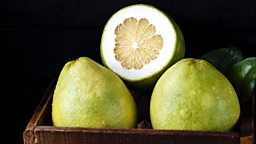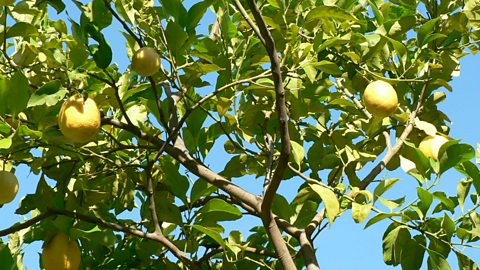Zest for life: Nine citrus secrets
Citrus fruits are the most widely grown crop in the world. They have vivid flavour possibilities and some sharp hidden histories. Sadly we often get stuck in a rut using a slightly shriveled slice of lime in a gin and tonic, orange juice straight from the carton and forget to buy lemons for Pancake Day. As the Food Programme goes on a citrus journey, we have gathered together some astonishing citrus facts.

1. Fruity phrases
Easy peasy lemon squeezy came from an old washing power advertisement, and the phrase entered the language. Most notably when Ollie in The Thick of It, played by Chris Addison, shouted hysterically “It’s not easy peasy lemon squeezy! It’s difficult, difficult, lemon difficult!”
Waxed citrus can be unsuitable for vegans!
2. Breakfast bonanza
The grapefruit comes from the Caribbean, where it was first hybridised. It was carefully designed to squirt its juice directly into your eye at the breakfast buffet in hotels.
3. The ant-idote
Cows like lemons. Apparently it helps their digestions. Ants don’t like lemons, so a lemon quarter where the blighters are getting in will put them off. This is also why you will never see ants at a cows’ cocktail party.
4. Waxing lyrical
Waxed citrus often have up to three different fungicides in the wax. This is worth bearing in mind if you're planning on zesting them or slicing them to leave soaking in a hot drink. The wax used on citrus can be produced using shellac which is made from insect secretions! This means that waxed citrus aren't suitable for vegans. Mmmm. Vodka and insect juice, anyone?
5. Good health news!
Citrus fruits are a great source of flavonoids, the same enzymes in red wine and dark chocolate that are good for the heart. Thus making a chocolate orange and a bottle of red wine the PERFECT health-giving snack*.
*This is untrue.

How lemons helped create the Mafia
Helena Attlee, author of 'The Land Where Lemons Grow' in conversation with Sheila Dillon.
6. Monkeying around
A tangelo is a cross between an orange, a grapefruit and a tangerine. It is called a tangelo because it couldn’t be called an orangutan.
7. The white stuff
Leaving the pith on your oranges provides 300 more milligrams of phytonutrients than citrus without. Phytonutrients are chemicals that plants produce. Whilst they're not essential for your body in the same way vitamins are, they are a great source of antioxidants and have anti-inflammatory properties. The phytonutrients in pith can help build your immune system and improve the way your body fights off disease. So perhaps it's good to take the pith.
8. Ripe language
Lemons turn from green to yellow because of temperature changes, not ripeness, so green patches are OK. Blue patches mean you’ve forgotten about them again and also explains that funny smell.
9. Office orange
Open one in three desk drawers in any office in the country, and you’ll find a lonely satsuma rolling around in it. Its sole purpose is to make you feel guilty while you eat a biscuit.

More from Radio 4 in Four...
-
![]()
The Food Programme
Sheila Dillon goes on a citrus journey, discovering vivid flavour possibilities and hidden histories.
-
![]()
Can you tell cider from cyder?
A Ciderologist clears up the confusion over cider and cyder.
-
![]()
Why do onions make us cry?
Jay Rayner asks Zoe Laughlin why onions make us cry.
-
![]()
Eight flavours you never knew went with strawberries
They might sound unusual, but trust us - they are truly delicious.




